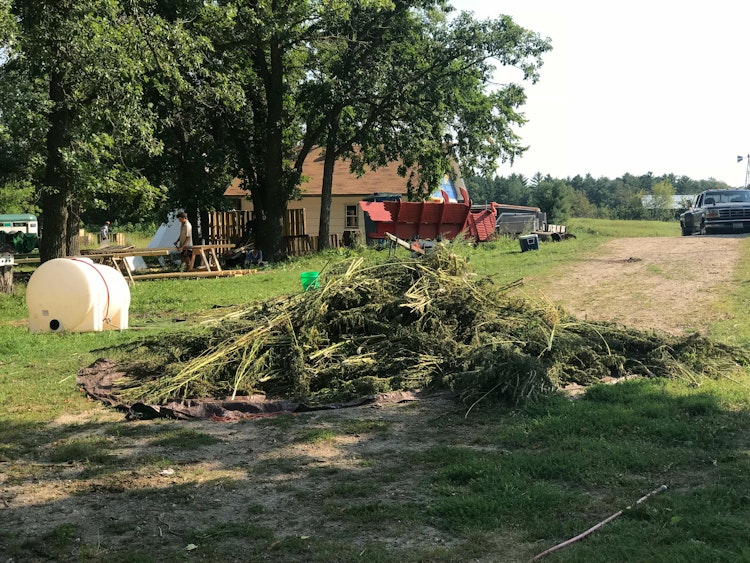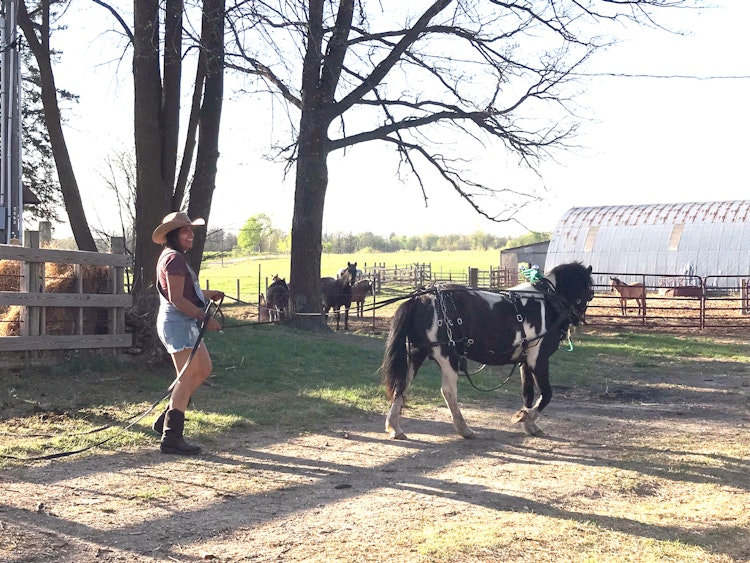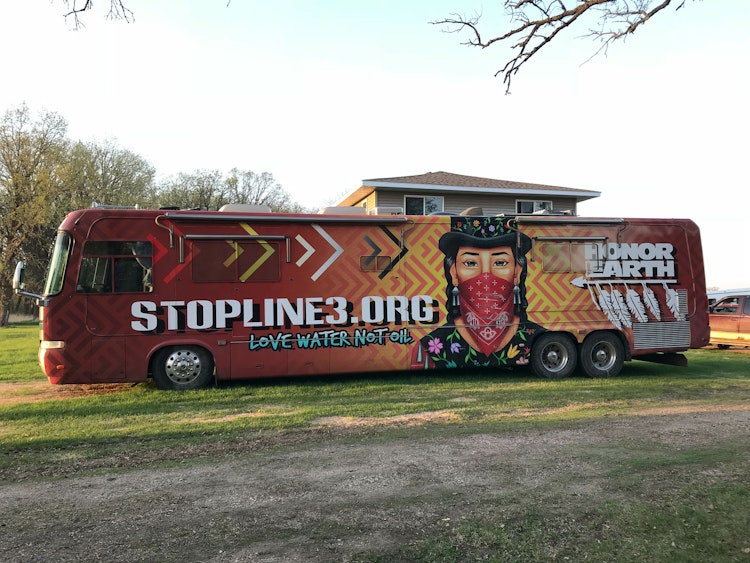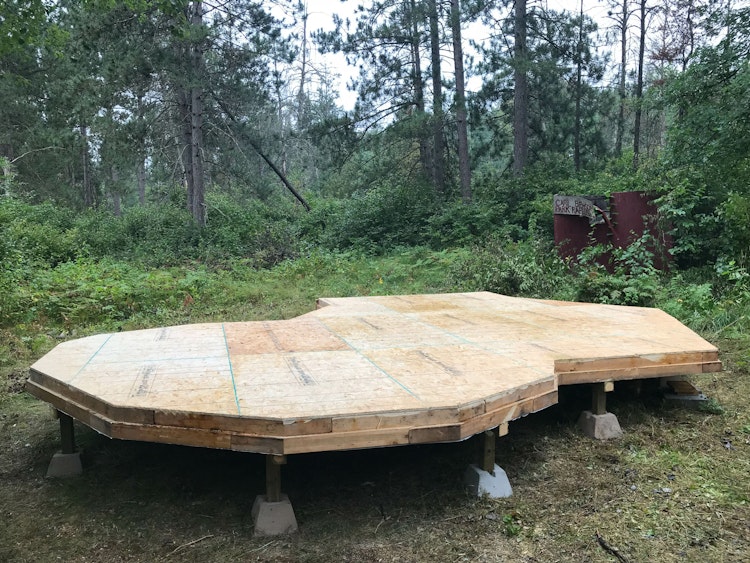

Dorothée Perret and Oscar Tuazon
Nicole Chang
In this text, publisher, editor, and writer Dorothée Perret and artist Oscar Tuazon travel to Winona LaDuke’s Hemp & Heritage Farm on the White Earth Nation, Gaa-waabaabiganikaag in northern Minnesota.
Plastics are the past, according to Winona LaDuke. Petroleum is so last season. From her hemp farm on the White Earth Nation, known in the Ojibwe language as Gaa-waabaabiganikaag, in northern Minnesota, LaDuke is patiently building the infrastructure of a new green economy based around sustainable, durable, biodegradable hemp fiber. The cloth of the future will be woven from local communities, local resources, local fiber, and local knowledge. Winona’s Hemp is working to restore traditional agriculture and create a new local economy of fiber production. A quiet revolution in how we think of clothing is taking place at a material level, questioning the fundamental precepts of how fabric is produced and used. It is a grassroots revolution, led by women.
LaDuke is a joyous presence, the smiling center of a hurricane of activity that encompasses harvesting and processing hemp plants on horseback, frequent speaking engagements around the country, and frontline organizing against a tar sands pipeline built across Ojibwe territory by Canadian oil company Enbridge.2 Founder and executive director of Honor the Earth, an Indigenous environmental organization, as well as a two-time Green Party Vice Presidential candidate and author of numerous articles and nine books, LaDuke was recently named one of 50 influential women over 50 by Forbes Magazine. Despite her broad influence and frequent appearances in films, broadcast news, and social media, LaDuke is a disarmingly humble influencer — and, perhaps foremost, a grandmother.
“We are responsible for things. We take care of our relatives. We only take what we need and we leave the rest. And we’re grateful. And so I approach this plant in this same way.” Inverting the extractive logic of industrial farming, which typically treats plants as a passive resource to be exploited, LaDuke approaches farming as a responsibility, a form of human care for living systems. And part of this responsibility is to repair the damage inflicted on the earth by industrialized farming practices. LaDuke is the founder of the White Earth Land Recovery Project, whose mission is to facilitate the recovery of the original land base of the White Earth Indian Reservation, while preserving and restoring traditional stewardship, language fluency, and community development through spiritual and cultural heritage. Farming hemp is just one of a multitude of ways LaDuke is seeking to use Indigenous ecological and agricultural knowledge to build the resources needed for a new green economy.

Outlawed throughout the 20th century due to its association with marijuana, the hemp plant in fact contains no THC, and as such has no psychoactive qualities. Caught in an industrial dispute between biofuels and petroleum, hemp cultivation was banned under the “reefer madness” hysteria of prohibition. The petroleum industry scored a major public relations victory, creating a fog of misinformation and criminalizing the plant to maintain market control. Today, we are finally becoming aware of the disastrous effects of an unrestrained petroleum industry that has monopolized not only the transportation industries, but much of the textile manufacturing used in an increasingly disposable, unsustainable fast fashion industry.
Hemp cannot get you high, but there is not much else it cannot do. Hemp was in fact one of the crops American farmers were required to grow under colonial law, a crop used to pay tax to the colonial government, and was a staple crop used to produce sailcloth and rope for the maritime trade. Due to the long fibers of the hemp plant, hemp has three times the tensile strength of cotton, and is naturally antimicrobial. Today, a vast array of building products using hemp fiber are being developed, including insulation, fiberboard, and bioplastics, laying the foundation for a single source of material for sustainable green building practices. Hemp oil extracted from the plant is edible on its own, but it can just as easily serve as a replacement for petroleum, and can even be used as biodiesel to fuel cars.
The Farm Bill of December 20182 finally legalized hemp production after more than 50 years, creating an opportunity for farmers and tribes to begin exploring the potential uses of the plant. Now that hemp is legal in the United States, innovation has been rapid. As a fast-growing crop, hemp is valued by organic farmers as a key element of restorative agriculture, capable of capturing carbon from the air and extracting toxins and metals from the earth. In rotation, hemp can balance soil damaged by industrialized fertilizer farming, restoring soil health. And of course, unlike synthetic fabric, hemp cloth is biodegradable, compostable, ready to return to the earth after it is worn. As the United Nations Intergovernmental Panel on Climate Change3 continues to sound the alarm over the fact that conventional agriculture is a major source of greenhouse gasses, regenerative practices are increasingly seen as a necessary element of sustainable alternatives.
Trained as a Harvard economist, LaDuke is particularly adroit as a systems innovator, seeing the potential of hemp fiber not as another “miracle crop” to be aggressively marketed and produced at industrial scale, but as a plant with fertile potential for small producers like herself and the collective structures nurtured within tribal communities. LaDuke’s farm is part of an ecosystem of farmers, processors, marketers, and consumers that keeps money in the region. This culture of rural self-sufficiency is well established in White Earth, and it is a unique asset LaDuke has developed over thirty years as an activist and Indigenous foods advocate. Manoomin, the wild rice that grows on lakes throughout White Earth territory, is the only rice native to North America and a fundamental part of the Ojibwe culture and mythology. According to oral history, it was predicted that the Anishinaabe would be forced off their land on the east coast of North America, pushed west by foreign invaders.4 The Ojibwe were to stop, it was said, when they came to a place where food grows on the water. Manoomin, or “good seed”, has been cultivated by Indigenous people for thousands of years, and remains an important staple of the Ojibwe cuisine. Endangered by the Enbridge pipeline that threatens to pollute the headwaters of the Mississippi and the network of lakes which depend on this pristine source of water, manoomin has become a valued export that supports the traditional harvesting practices of tribal members, and is one of the most popular products sold by Honor the Earth. The region’s other signature harvest is Pancakes Not Pipelines maple syrup, hand tapped, collected and boiled according to tribal tradition.
These products are more than regional flavors, they support a broader project of tribal sovereignty over traditional food resources and equity in our food system, part of an effort to decolonize agriculture, cutting out the corporate intermediaries and returning power to consumers and small farmers rooted to the land.

In LaDuke’s vision, hemp fiber is not a cash crop, but a spoke in a wholistic circular economy. “We used to make fabric in North America, we had a textile industry, but we don’t any longer,” she says. Fittingly, her next goal is to restore the neglected mill infrastructure that was, until recently, used to transform hemp plants to raw fiber. This will require, and create, an economy that understands value not primarily as a financial equation, but as a cycle of regeneration and restoration of whole communities. As inspiring as Winona’s Hemp and Heritage Farm is as a single farm, the real power of her idea is as an element of a collective system incorporating farms, mills, artisan producers, and consumers. As such, a system is gradually being built, and all involved are taking steps towards realizing environmental justice in their community; the solution is taking form.
Artists have been drawn to work with LaDuke since the beginning of her long career as a public figure, and in the community she has built, art is not relegated to decoration, but plays a central role in her vision for a petroleum-free future. In 2017, in the wake of the movement at Standing Rock, Honor the Earth commissioned NSGRNTS, a collective of Indigenous artists, to paint a monumental mural in downtown Duluth. Ganawenjiige Onigam (“She Watches Over Duluth” in the Ojibwe language) depicts a traditional jingle dress dancer, and has come to stand as a potent symbol, a witness for land and water. The image has been reproduced on T-shirts, billboards, and as a wraparound print on the Honor the Earth bus, a bold presence throughout the ongoing protest movement against Enbridge Line 3. More than an icon of Indigenous resistance, Ganawenjiige Onigam incites curiosity and inspires an engaged community of artists.
On the first of our three visits, in May of 2018, we began seeing Honor the Earth billboards on the roads outside Ponsford, with images of smiling farmers on horseback above the words: WELCOME WATER PROTECTORS. But we struggled to find our way to the farm at first and stopped in the nearby town of Callaway, where the volunteers at KKWE Niijii Radio5 cheerfully drew us a map. LaDuke is a lightning rod in rural northern Minnesota; her opposition to Line 3 remains unpopular with some local residents, but somehow, she seems to be a beloved figure in the small farming communities dispersed throughout the rice lakes. Like so many other artists, we were compelled to make a pilgrimage to White Earth in support of the movement to protect the headwaters of the Mississippi River, and we had begun to think deeply about whether our practices as artists and designers could contribute anything to the very real-world questions LaDuke addresses in her writing.
“You’re here!” Winona LaDuke shouted, guiding a horse by the reins. Winona’s Hemp and Heritage Farm is run on horse power, and she had just returned from the field. The silkscreen studio was a hive of vibrant activity, full of young hands busy learning the craft. The farm stand shop was stocked with locally harvested manoomin, maple syrup, and Honor the Earth’s own brand of coffee. Coffee cups, patches, T-shirts and beaded medallions bearing “Water Protector" and “Water is Life" designs were arrayed on the shelves. Outside, college students worked the hemp harvest, stacking and drying harvested plants, stripping leaves from the plants, and preparing the long stalks of the plant for processing. Painters were just finishing a mural on the face of a hay barn, a majestic Ojibwe horse design. On that first visit, we arrived from a cross-country road trip with a section of pipe and an Aspen tree we had picked up in Colorado, an offering we intended to plant in LaDuke’s honor. She graciously offered space to install this living protest sculpture on the Akiing, Honor the Earth’s agricultural land. We planted the tree as a beginning, a commitment to return to continue the work.

LaDuke planted a seed in our minds too. Her radical idea of art as an integral component of political thought and social action had begun to completely transform our understanding of what art practice is capable of. A few months later, in August, we returned to water the tree we had planted, and to continue working towards her expansive form of public art deeply rooted in local community. As the population of water protectors supporting the resistance movement had swelled during the summer months, LaDuke had acquired an 80-acre plot of land straddling the headwaters of the Mississippi River, directly within the path of the proposed Enbridge fracked tar sands pipeline. This frontline camp was the staging area for the growing community of activists, Indigenous leaders, and environmentalists drawn from across the continent. Though distinct from the agricultural activities of Winona’s Hemp and Heritage Farm, the communities of the two spaces are symbiotic and complementary. Workshops on nonviolent resistance, constructing tree sits, and frontline medical care were being staged by a cohort of committed young organizers and a revolving cast of sympathetic participants. Grumbles the chef prepared a menu of locally harvested native foods in the open-air kitchen, served on lawn chairs around the open flame of a Dakota fire pit.
We arrived as a crew of four artists and amateur architects with the components of a modular zonohedron, a crystalline geometry developed in 1968 at the first hippie commune, Drop City. Could such a structure be useful in any way in this context? Given the urgency of the resistance efforts, and the pressure being applied against peaceful protesters by state and county law enforcement, utility is the fundamental standard here. For a work of art, pragmatism is an unfamiliar criterion, but this principle is essential to the democratic creative process of Honor the Earth. Before we began to build, our project needed to be vetted and sited in a spontaneous kind of field critique led by Tara Houska,6 a tribal lawyer and citizen of Couchiching First Nation and director of Giniw Collective, who is responsible for the camp. It was agreed we could begin by building a floor, a kind of platform to support the ongoing activities of the camp.

Winona’s Water School will continue to be built gradually as time and resources allow. Unlike a typical work of public art, with a proscribed temporary timeframe, the school is envisioned as a long-term process with an indeterminate completion date. Though the protest movement around the Enbridge pipeline came to a public culmination during the completion of the pipeline at the height of the pandemic in fall of 2021, the repercussions of the project and the organized attempts to prevent it will be long-lasting. Water protectors, including LaDuke herself, face elevated charges that essentially criminalize their constitutionally protected protest of “critical infrastructure”; an unprecedented militarization of civil law to intimidate peaceful activists performing nonviolent action and exercising free speech. The environmental damage is beginning to be seen in massive “frack-outs” of toxic chemicals used in the pipeline construction process, and pollution of subterranean aquifers.
The community that has grown up around Winona’s Hemp and Heritage Farm, the pipeline protest camps, and the wild rice lakes of northern Minnesota is resilient, and like LaDuke, takes the long view. To construct an alternative green infrastructure is a massive undertaking, but it is something we each have an individual responsibility to do, and the means are accessible, the steps are clear. Build with sustainable resources, harness renewable solar energy, rely on local networks. The School is a test case, and it will adapt as we go. A school begins with a library, and so an ongoing aspect of Winona’s Water School is to develop a library of teachings on Indigenous ecology including works by LaDuke, Eddie Benton Benai, LaDonna Brave Bull Allard, Leonard Peltier, Louise Erdrich, Clyde Bellecourt, Sitting Bull, Chief Littlefeather, and others. A pantheon of Anishinaabe environmental thought, the Water School is intended as a tribute to LaDuke’s vision of art as pragmatic, politically engaged, collective work. Winona’s Water School is intended as a structure that continues learning through the process of its construction and inhabitation. We are far from being finished, but it feels like a good beginning. Working in this way, we hope to contribute to LaDuke’s vision of “growing a new green revolution”.